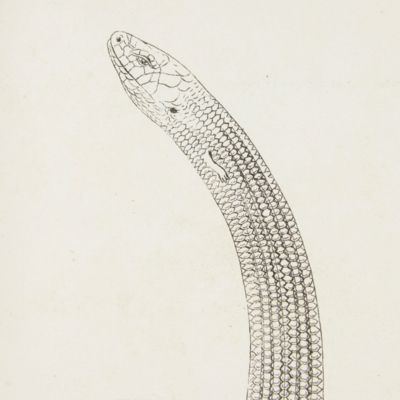Sicherer, P. F.
Seps tridactylus. Dissertatio inauguralis quam consensu gratiosi medicorum ordinis praeside Guilielmo Ludov. Rapp.
Tubingae [Tübingen], Richter, 1825. 4to (23.8 x 19.7 cm). 16 pp.; one large, folded lithographed plate. Without wrappers (as issued).
A rare work, the first dealing exclusively with an almost snake-like lizard, with peculiar, rudimentary legs, each bearing three toes, hence the epithet tridactylus. This is the thesis of the medical doctor, art benefactor, bibliophile, and herpetologist Philipp Friedrich Sicherer (1803-1861) from Heilbronn, Germany. The inauguration was supervised by the German medical doctor and naturalist Wilhelm Ludwig von Rapp (1774-1868), who had studied with Cuvier in Paris (see Adler). The British Museum Catalogue lists Rapp as author too, but the tradition of professors writing their students’ theses had been abandoned years earlier, and the work clearly lists Sicherer as (single) author. The genus name Seps has mislead some people into thinking that medical doctor Sicherer's thesis dealt with sepsis! The species discussed and illustrated is Lacerta chalcides L., now known as the three-toed lizard, occurring in Northern Africa, Sicily, Sardinia, and parts of continental southern Italy. The synonymous name tridactylus was introduced by Laurenti in 1768, and the genus Seps by Lacépède, in a non-binominal work. Sicherer provided a correct synonymy, yet preferred the more descriptive name tridactylus over the older, valid chalcides. Edges a bit frayed; very light damp-stain in the lower margin; fold in the top outer corner of the plate; otherwise, very good, unmarked. Adler III, p. 117; Cat. BM(NH), pp. 1646, 1921. Not in Nissen.


![image for [Jugendstil gouache] "Roter mohn" [Poppy].](https://www.schierenberg.nl/media/cache/product_thumb/72461/72461_x.jpg)


